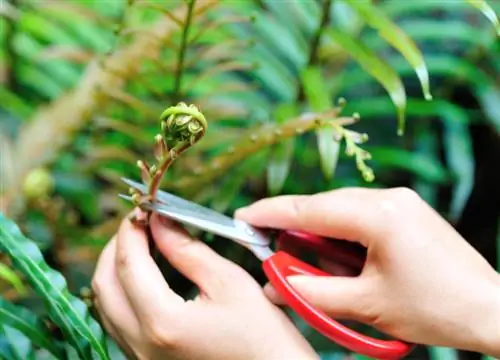- Author admin [email protected].
- Public 2023-12-16 16:46.
- Last modified 2025-01-23 11:20.
Many ferns grow in the garden without any help. But what will happen to them in winter? Do they tolerate frost or should they be protected? Here you will get a good overview of hardy and sensitive fern species as well as tips for wintering.

Are ferns hardy?
Hardy ferns that tolerate frost well are native to Central Europe. These include maidenhair fern, ostrich fern, worm fern, striped fern, rib fern, deer's tongue fern, spotted fern, bracken fern, sickle fern, golden scale fern, script fern, thorny shield fern, red veil fern, elephant trunk fern and bell tree fern. Sensitive, tropical species should stay indoors in winter.
It depends on the type of fern
There are numerous species of ferns that survive the German winter effortlessly and undamaged. These primarily include those species that are native to Central Europe. You can safely leave the following fern species unprotected to the frost:
- maidenhair fern
- Ostrich fern
- worm fern
- Striped fern
- Rib Fern
- Deertongue Fern
- Spotted Fern
- bracken
- Sickle Fern
- Goldscale Fern
- font fern
- Thorny Shield Fern
- Red Veil Fern
- Elephant trunk fern
- bell tree fern
The following species tolerate little or no frost as they mainly come from tropical regions. They are more suitable for indoor culture and should stay indoors in winter:
- Sword fern
- Cycad fern
- Tree Ferns
- Filigree Fern
- Hare's Foot Fern
- Cliff fern
- staghorn fern
How can ferns be protected outdoors?
If you plant your fern outdoors in autumn, you should protect it in the first winter. In addition, all sensitive species such as the silver tree fern and crown fern should be protected from severe frost.
How to do it:
- If there is a trunk, wrap it with straw mats or fleece
- Cover the root area with a layer of leaves and/or brushwood
- Tie the fronds together or cut them in half
- Don't fertilize anymore from September at the latest
- remove from protection from March/April
How do evergreen room ferns overwinter?
House ferns should also be overwintered or kept in a different place during the winter than in the summer. You will be placed in a cooler room with temperatures between 12 and 15 °C. The warmer it is, the more light the plants need. If necessary, an artificial light source must be used.
Water the indoor ferns less in winter, but in such a way that the soil does not dry out. Increase humidity by misting with water regularly. Fertilizer should not be added. From March the indoor ferns will return to their originally intended location. This is important before new fronds form.
Tips & Tricks
Overwintering in a warm living room is not a suitable place for ferns. Due to the dry heating air, they are susceptible to pests and are often attacked by spider mites.






